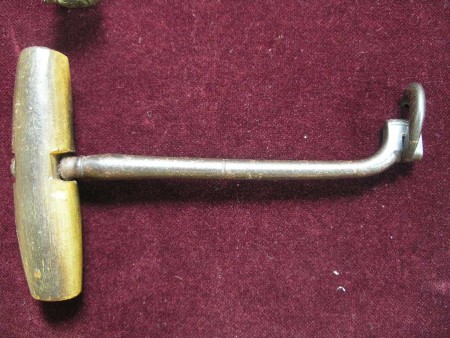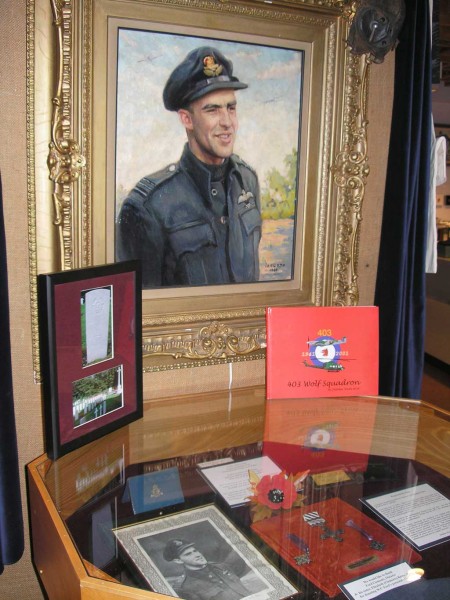We have a number of exhibits featuring notable historic figures, and that explore various aspects of early settler life in Liverpool, and surrounding areas.
- Colonial Medical Display
- Tools of the Lumberman
- The Liverpool Larrupers
- Sports Exhibits – Queens Place Emera Centre
- Leslie Sydney FORD – Distinguished Flying Cross with Bar
- Bank of Liverpool/Bank of Acadia
Colonial Medical Display

We are very fortunate to house the medical tools of Dr.John Falt. Dr. Falt is mentioned several times in the Perkins diary as providing good health care to the folks in Liverpool and to the Perkins family itself.
A modern eye gazing upon these tools may think how primitive… how unhealthy. To a colonial Nova Scotian, these were the latest in medical equipment. Several items, the leech carrier, the blood letting tool and the blood catching cup, remind us that at one time our blood was thought to be the cause of illness and by removing it we would get better.
The dental extraction tools look more like instruments of torture. In our modern world of antibiotics, we forget that a decayed tooth could poison us. Removal, no matter how painful, was preferable to the other option.
Come and visit and we will share the tools and practices of not only medicine in colonial times but also the medicines of the Mi’kmaq people and those “cures” of more recent history.


Tools of the Lumberman

At the Queens County Museum we can tell you who let the (Log) Dogs out. Better yet we can show you the LOG DOGS.
In our Lumbering display we show you’re the tools used on the backwoods by the lumberman a century a go. We tell the story of the old log drives down the Mersey to the sawmills of Milton. See the evolution of the axe and saw. We challenge you to find the one saw that was not used in the woods.
The Liverpool Larrupers

The Liverpool Larrupers won the Nova Scotia Senior Baseball Championship in 1938, 1939 and 1940 after long battles with their arch rivals the Yarmouth Gateways.
From 1939 to 1941 the Larrupers also captured the Maritime title. Their chief opponents were the St. Stephen New Brunswick club.
The Larrupers domination of the sport was recognized by the Chronicle Herald, when they gave permanent possession of the Chronicle Herald Cup to the Larrupers in 1940.
After World War 2 the Larrupers competed in the Halifax and District League. Lazy summer days were accented with fevered pitches at the ball park. Unlike the player of the past, these Larrupers were semi pro made up of College players and old pros. In 1955, the team captured the league crown.
Sports Exhibit - Queens Place Emera Centre

The Liverpool Larrupers won the Nova Scotia Senior Baseball Championship in 1938, 1939 and 1940 after long battles with their arch rivals the Yarmouth Gateways.
From 1939 to 1941 the Larrupers also captured the Maritime title. Their chief opponents were the St. Stephen New Brunswick club.
The Larrupers domination of the sport was recognized by the Chronicle Herald, when they gave permanent possession of the Chronicle Herald Cup to the Larrupers in 1940.
After World War 2 the Larrupers competed in the Halifax and District League. Lazy summer days were accented with fevered pitches at the ball park. Unlike the player of the past, these Larrupers were semi pro made up of College players and old pros. In 1955, the team captured the league crown.
Leslie Sydney FORD – Distinguished Flying Cross with Bar

“Syd” Ford was born in Halifax, Nova Scotia on 30 December 1919. His youth was spent in Liverpool, Nova Scotia, where he was often seen sailing his small craft in the harbour. He attended Acadia University but ended his education to enlist in Halifax in 1940.
His flight training began in Canada and he was awarded his wings in January 1941. From Canada he was posted to England in February 1941 where he received further training. He served with No. 403 Squadron, April to September of 1941 ; No. 402 Squadron, September 1941 to January 1942; No. 175 Squadron, February to July 1942, returning to No. 403 Squadron as “B” Flight Commander in July 1942.
His promotion to Commanding Officer came in August of 1942. His next posting was to Digby as Wing Commander (Flying), in April of 1943. Ford was killed in action, 4 June 1943 while attacking enemy shipping off the Dutch coast. With four other pilots of No. 402 Squadron, he attacked three E-boats and was shot down into the sea.
Syd Ford was credited with 6 aerial victories including 19 August 1942, when he led his squadron in support of the combined operations against Dieppe with great skill. Several enemy aircraft were destroyed, two of which were shot down by Squadron Leader Ford. Throughout, he was an inspiring example instilling great confidence in his fellow pilots.
As a flying officer he carried out many operational missions, having been engaged in fighter sweeps and in bombing attacks on land and sea targets. He participated in two attacks when two mine sweepers and an enemy destroyer were sunk and two destroyers were damaged. He was a keen and zealous flight commander and leader.
Wing Commander Ford is buried in the General Cemetery at Vlieland, Frisian Islands, Friesland, Holland.
Bank of Liverpool/Bank of Acadia

During the 1870’s, Liverpool had two (short-lived) banks: Bank of Acadia and Bank of Liverpool. Both banks issued their own currency. See Bank of Acadia note shown on the right.
The Bank of Acadia
The Bank of Acadia was only open for approximately 120 days between 1872 and 1873. That makes it the shortest-lived bank in the history of Canada. Its president, Thomas Robert Pattillo, was a prominent Liverpool businessman. The Bank was located on the Main Street of Liverpool across from the current Town Hall Center.
From its beginning it was focused on economic development and made several large loans to local Lumberman and Shipbuilders. The bank ran into difficulty when the world economy suddenly panicked and the debtors were unable to repay their loans.
At the time there were many rumours of shifty business practices however the poor economic climate was the true cause of the failure. The bank tried to reimburse its customers but did not have the liquid assets to meet that desire. The failure of the Bank of Acadia took a toll on the health of Mr. Pattillo, who died the next year of a heart attack.
The Bank of Liverpool

Reference books suggest that the corporate life of The Bank of Liverpool in Nova Scotia was 1871 to 1879. The bank was actually closed from April 1873 until 1878. It, too, was located on Main Street, Liverpool, near the present day Dixie Lee. After its closure in 1873, it reopened in 1878 for a fruitless attempt to regain its business. The same economic panic that caused the failure of the Bank of Acadia proved fatal for the Bank of Liverpool. The Bank of Nova Scotia took over took over the meager assets of the defunct Bank of Liverpool.
Note on the bank notes: Many visitors ask why a $4.00 bank note. We must go back to the time they were printed; a skilled carpenter could be making about $2.00 per day for an 8 to 10 hour workday. A shop girl may make less than a dollar a day. Therefore $4.00 would be a week’s wages for that shop girl and two notes would equal the carpenter’s wages for the week.
